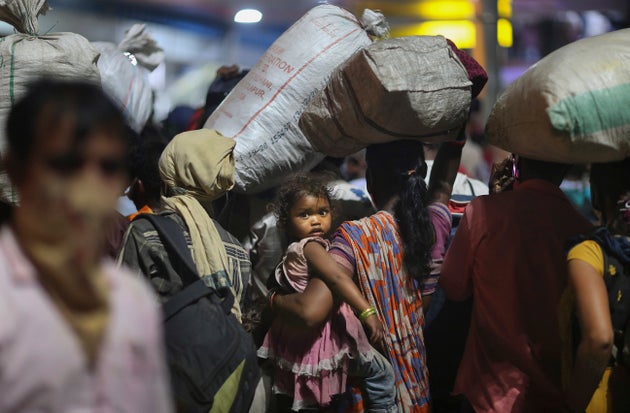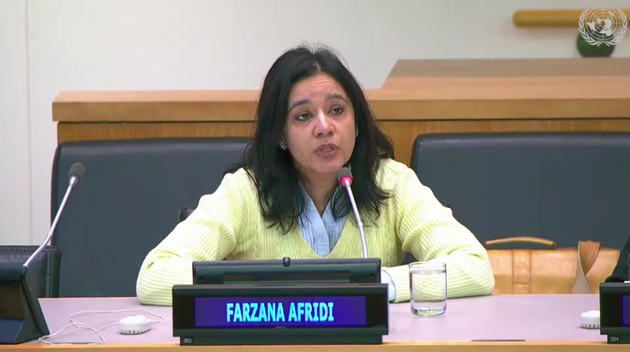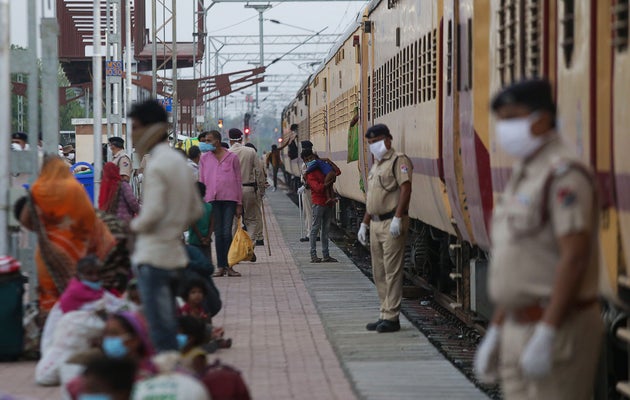
MGNREGA Can’t Be The Modi Govt’s Only Answer To Migrant Jobs Crisis. An Economist Explains Why
Farzana Afridi of the Indian Statistical Institute on how the government should provide jobs to the migrants who have returned home.
by Rachna KhairaAs millions of migrant workers return to their villages, hard hit by the national lockdown that left them without jobs and wages, the Indian government is staring at a serious economic crisis. While the government has announced an economic stimulus package that it claims adds up to Rs 20,000 crore, this has not convinced poor labourers that they can stay on in the hope of a stable future.
The fallout of this will be huge, said Farzana Afridi, Lead Academic for IGC India and Associate Professor, Indian Statistical Institute, Delhi, in an interview.
“The urban industry is expected to face a huge crunch of workers, especially in construction jobs and other petty business, while rural areas will have surplus numbers with almost no job opportunities for them. After all, you cannot put millions of skilled workers on the Mahatma Gandhi National Rural Employment Guarantee Act (MGNREGA) in the long run,” she said.
For the latest news and more, follow HuffPost India on Twitter, Facebook, and subscribe to our newsletter.
Afridi, whose research areas include female labour force participation, also spoke about how the government should provide jobs to the migrants who have returned home and why it should increase its risk appetite for borrowing.
Edited excerpts:
The coronavirus pandemic has exacerbated a crisis in the everyday existence of migrants to unprecedented proportions. Many labourers who have travelled back to their villages have said that they are reluctant to return to cities again. How serious is the situation and what impact will it have on India’s economy?
The migrants have returned to their villages thinking it to be a permanent job-loss scenario. They did not have money to sustain themselves and the food grain and other support provided by the government were inadequate to prolong their stay at their work stations. The move will have serious repercussions as the urban industry is expected to face a huge crunch of workers, especially in construction jobs and other petty business, while rural areas will have surplus numbers with almost no job opportunities for them. After all, you cannot put millions of skilled workers on the Mahatma Gandhi National Rural Employment Guarantee Act (MGNREGA) in the long run. Instead, the government should make efforts to ensure the early return of such migrants to urban areas.
The imbalance hence created between the urban and the rural economies is also expected to push the GDP further down and, as per the speculations made recently by some economists, can even lead to depression. Also, it will be a permanent job loss for the majority of unskilled labourers. The cost of labour in certain sectors will escalate as certain industries will now focus on mechanising their units and require highly skilled labour to run those machines. The inequality termed as the skill-biased technical change will create a rift of job opportunities between the skilled and unskilled workers.
Many BJP-run state governments have taken this opportunity to dilute or even abolish crucial labour laws on the pretext of reviving economic activity. What will this mean for underpaid, overworked labourers who were already struggling to make ends meet?
Presently, the situation is very dynamic. The government has realised that it will be hard to find the labour in urban areas as the majority of them have migrated back to their homes. So, the industries in urban areas may have to manage their business with labourers having fewer skills and low productivity and hence the flexibility is required by the firms to be able to hire them. But what is more worrying is the fact that the government has not ensured a safe work environment for labourers during pandemic times. We are aware that in India, most of these light manufacturing units such as garments, textiles and footwear and service sectors do not meet safety and health requirements as per international norms to lower their labour and operational cost. So, if the recent changes introduced in the labour laws without safeguarding the interest of the labourers are made a permanent provision, it will be a step back in terms of ensuring workers’ safety and their productivity, especially in post-pandemic times. It will not only lower their productivity but will also affect their mental health in the long run.

Almost 90% of India’s population works in the informal economy. ILO has predicted that as a result of the crisis and subsequent lockdown, about 400 million workers will fall deeper into poverty. Do you think that Nirmala Sitharaman’s economic stimulus package will be able to deal with this unemployment crisis?
The government at present does not want to take any risk as the country’s economy is already in shambles. More borrowing will increase the fiscal deficit and will impact its credit ratings at the global level as well as on the Foreign Direct Investments (FDIs). Economists are of the opinion that if we do not increase our consumption, our growth rate will continue to stay flattened till the next five years. The union government instead of pushing ahead the welfare of migratory workers in the ongoing pandemic situation has delegated its responsibility to the respective state governments without holding any prior consultations, which is quite worrisome.
For example, if we consider the MGNREGA scenario, the scheme is almost non-existent in many states. How will cash-crunched states like Bihar and Jharkhand provide employment to millions of its migrants coming back from urban areas and who do not have any alternate source of income in their families?
Also, if we take the case of Rs 5,000 crore to be granted as a working capital loan worth Rs 10,000 to the street hawkers, this will not work as it will take a lot of time and documentation to be able to grant the loan to people who are in urgent need of cash. Many economists have suggested depositing Rs 5,000-7,000 directly into the accounts of migrant workers and urban poor as interim relief but NITI Aayog officials have confessed to us in various meetings that they do not have a mechanism to identify such beneficiaries.
Do you accept this claim by NITI Aayog officials that it was not possible to identify urban poor and migratory workers in the informal sector in a situation like this when the whole nation was put under strict lockdown?
How can the government claim this when it boasts of a highly successful Aadhaar-enabled banking system running in the country? Also, millions of accounts linked to Ujjwala scheme and the same number of job cards under MGNREGA can also provide financial assistance in no time.
It is a matter of shame for the government to claim this during a pandemic. I think they are hiding behind their own shortcomings as they are not willing to take any risk of borrowing in an already crunched economy.
Several economists have dismissed the government’s claim that the economic measures announced equal 10% of India’s GDP. They have claimed that the actual Covid-19 package is about 1% of the total GDP and the rest is repackaging and appropriation of liquidity measures announced by the RBI. How far is this true?
Yes, the stimulus announced in this package is not from the new money but the money which is already in the circulation of the banking system. Stimulus generally deals with the new money and not from the existing source. The majority of the provisions announced in the package are loans to provide liquidity for a longer period. For example, if the government has claimed that it will deduct your TDS by 0.25% less than the regular norms, it doesn’t mean that it has given you a permanent waiver. They will deduct it once you will file your income tax returns. This is just a delayed tactic and the package has only given you liquidity for some time.
With this package, the government has only played with the numbers and the new money (stimulus) is not more than 2% of the GDP, which mostly includes MGNREGA allocations.
The government has asked states to facilitate the loan provisions proposed under the economic stimulus package. It did not hold any prior consultations with states with regard to their capacity and willingness to carry this forward. What challenges will states face if they cater to the loan provisions announced in the package?
It seems a Herculean task for states as they are already facing an acute economic crunch. After the implementation of the GST, the revenue going to states has decreased. Also, the majority of the workers who were sending remittances to their families in these states have now become jobless and are returning home. Also, on the political front, non-BJP-ruled states will be least interested in disbursing loans in the name of PM Modi.
During the COVID-19 pandemic crisis, a huge void was witnessed in terms of states reaching out to those in need due to economic constraints. In a major respite, civil society came to the rescue of people and filled the gap in the majority of the places. They played a major role during the sudden lockdown announced so abruptly by the central government. It was an unprecedented situation and even we as economists had never imagined that millions of workers would suddenly become jobless and come on roads in search of food and shelter.

Despite running missions such as Make In India, Skill India, and Digital India, we are currently relying on MGNREGA to provide employment to rural workers. Do you think that along with MGNREGA, the government should have allocated some funds for the other missions to boost the remote jobs and training components in India? Which sectors have the potential to offer remote job availability to migrants, especially those coming from other countries?
Post the pandemic, the world is going to witness a new era of job prospects and employer preferences, where countries will give preferences to their own citizens and industries. This will also have an effect on international migration. For example, Kerala had a huge share of migrants going to the Middle East in search of jobs. Now they are coming back.
A recent report by the World Bank says that post the pandemic, India will be a major loser of international remittances in the world. The worst situation will be that there will be surplus numbers of skilled migrants in states like Kerala and unskilled forces in states like Bihar.
So the government should utilize such opportunities to hold back this talent ‘stranded’ in our country post the pandemic to boost its programmes like Skill India and Digital India and to create training and job opportunities for the rural youth. So here I again repeat that the government should increase its appetite to take risks to create such resources so as to maintain an equilibrium of the urban and rural economy.
The international migrants can be utilized to strengthen major sectors such as tourism, skill development, IT, Edtech, and medical services. The rural youths can be trained online for services like medical attendants, hospitality sectors, and other skills.
During COVID-19, the Union and state governments worked in separate compartments by physically sealing the borders and also did not share information and other resources. What according to you should have been done in such a situation?
A situation like COVID 19 requires the government to act in real-time but unfortunately, it did not act in this way. When companies like Google and Facebook are giving real-time data of migrant workers on the road, the state governments have failed to coordinate and share this information in real-time to facilitate their temporary rehabilitation and welfare enroute with support from civil societies and volunteers. This was not a difficult task for the government but it seemed to have lost the opportunity to bring millions of informal workers on board.
What are India’s biggest challenges in the ongoing trade-off between health and economic considerations?
Developing countries like India have to choose between lives and livelihood and they have realized that resuming livelihood is much more important as it will have a more devastating effect in the long run. Also, the death rate due to the Corona pandemic is comparatively low in India amongst the people who have tested positive. So it was fine that economic activities have begun to resume from the past week.
Furthermore, we need to plan it very meticulously. Public health investments are the need of the hour and so is the coordination between the center and the states. In the short term, there is a need to protect the vulnerable people and in the long term, there is a need to increase demand and productivity. After all, you cannot put millions of workers on MGNREGA for the whole year. Conducive situations should be created so that workers feel the need to return to their work stations without much delay.
When lakhs of urban workers move to rural areas with negligible job opportunities, what will the strain on resources be? What can the government do to prepare for the increase in poverty and unemployment?
The biggest constraint will be on the public health infrastructure as it is already facing an acute shortage of doctors and other infrastructure. Also, there will be inadequate jobs and insufficient supply of food.
The government should adopt various technological advances to provide job opportunities to these jobless migrants. Under the skill India mission, the government has adopted various job-providing platforms but have not integrated them into a common platform. This will be very useful in such scenarios as a national platform will cater to the needs of job-seekers and job providers in every nook and corner of the country. Under this common platform, one can find drivers, cooks, plumber, electricians and beauticians living in nearby places.